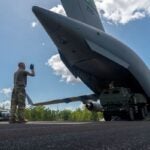
Air Force Gen. Arnold Bunch Jr., the head of Air Force Materiel Command (AFMC), said on Sept. 21 that the Air Force remains committed to the close air support (CAS) mission, even as the service proposes the retirement of 42 A-10s in fiscal 2022. The Pentagon has classified a study that used 2018 and 2019 flight test data to compare the effectiveness of the Lockheed Martin [LMT] F-35 and the A-10 for close air support, airborne forward air control, and…














